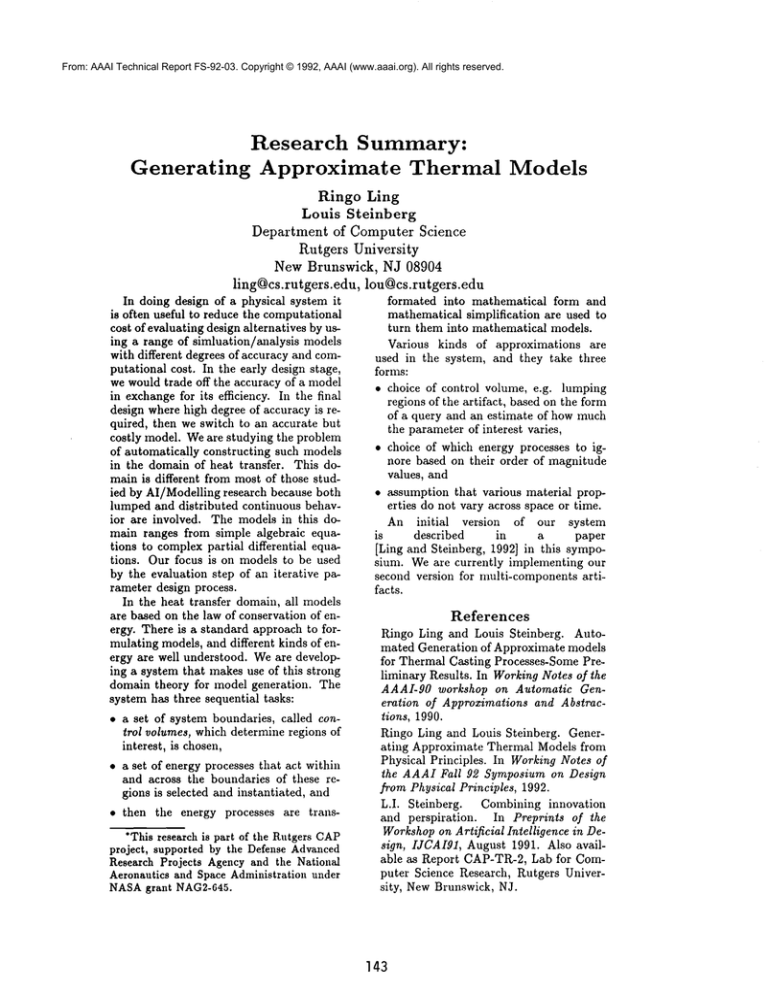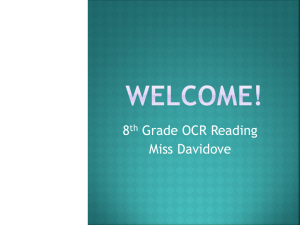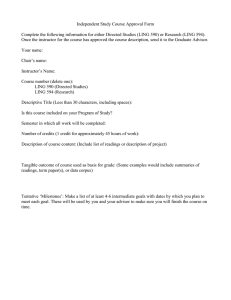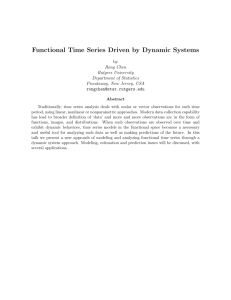
From: AAAI Technical Report FS-92-03. Copyright © 1992, AAAI (www.aaai.org). All rights reserved.
Generating
Research
Summary:
Approximate
Thermal
Models
Ringo Ling
Louis Steinberg
Department of ComputerScience
Rutgers University
NewBrunswick, NJ 08904
ling@cs.rutgers.edu, lou@cs.rutgers.edu
In doing design of a physical system it
is often useful to reduce the computational
cost of evaluating design alternatives by using a range of simluation/analysis models
with different degrees of accuracy and computational cost. In the early design stage,
we would trade off the accuracy of a model
in exchangefor its efficiency. In the final
design where high degree of accuracy is required, then we switch to an accurate but
costly model. Weare studying the problem
of automatically constructing such models
in the domain of heat transfer. This domain is different from most of those studied by AI/Modelling research because both
lumped and distributed continuous behavior are involved. The models in this domain ranges from simple algebraic equations to complex partial differential equations. Our focus is on models to be used
by the evaluation step of an iterative parameter design process.
In the heat transfer domain, all models
are based on the law of conservation of energy. There is a standard approach to formulating models, and different kinds of energy are well understood. Weare developing a system that makes use of this strong
domain theory for model generation. The
system has three sequential tasks:
¯ a set of system boundaries, called control volumes, which determine regions of
interest, is chosen,
¯ a set of energy processes that act within
and across the boundaries of these regions is selected and instantiated, and
¯ then the energy processes are trans*This research is part of the Rutgers CAP
project, supported by the Defense Advanced
Research Projects Agency and the National
Aeronautics and Space Administration under
NASAgrant NAG2-645.
formated into mathematical form and
mathematical simplification are used to
turn them into mathematical models.
Various kinds of approximations are
used in the system, and they take three
forms:
¯ choice of control volume, e.g. lumping
regions of the artifact, based on the form
of a query and an estimate of how much
the parameter of interest varies,
¯ choice of which energy processes to ignore based on their order of magnitude
values, and
¯ assumption that various material properties do not vary across space or time.
An initial
version of our system
is
described
in
a
paper
[Ling and Steinberg, 1992] in this symposium. Weare currently implementing our
second version for nmlti-components artifacts.
References
Ringo Ling and Louis Steinberg. Automated Generation of Approximate models
for Thermal Casting Processes-Some Preliminary Results. In Working Notes of the
AAAI-90 workshop on Automatic Generation of Approximations and Abstractions, 1990.
Ringo Ling and Louis Steinberg. Generating Approximate Thermal Models from
Physical Principles. In Working Notes of
the AAAI Fall 92 Symposium on Design
from Physical Principles, 1992.
L.I. Steinberg. Combining innovation
and perspiration.
In Preprints of the
Workshopon Artificial Intelligence in Design, IJCAI91, August 1991. Also available as Report CAP-TR-2, Lab for Computer Science Research, Rutgers University, NewBrunswick, NJ.
143





